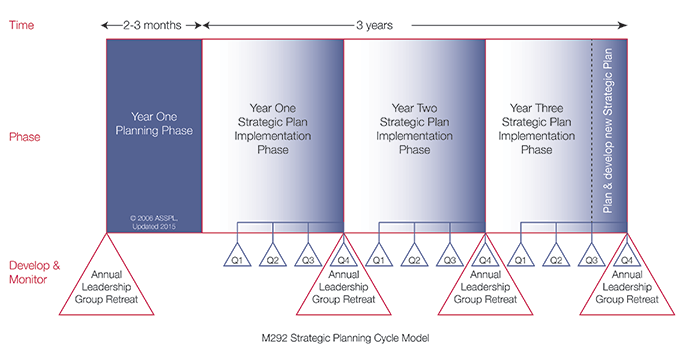strategy-risk
Strategic Planning Principles and Practices
Published: October 5, 2023
Read Time: 5 minutes

Accepting a position as a director requires a willingness to personally grow and develop one’s governance and leadership skills, experience and knowledge, and a commitment to allocating the necessary time to fulfil directors’ corporate governance roles and responsibilities.
Strategic leadership is one of the four overarching governance responsibilities of a board; the most well-known manifestation of a board’s strategic leadership is the development and driving of a strategic plan, in partnership with the chief executive officer (CEO) and executives/senior managers.
Whilst an increasing number of boards are more robustly developing and implementing strategic plans in order to develop their services and grow their organisations, there remains a wide disparity in the understanding and practical application of contemporary strategic planning principles, frameworks, systems, processes, documents and tools.
Strategy is an ongoing process
Strategy should not just be a one-off event or discussion. It should be an ongoing process of strategic thinking, strategic discussions and strategic decisions. The key outcomes of the strategy process are agreement and clarity on the organisation’s strategic intent, strategic direction, strategic destiny and the associated strategies and projects to enact these.

The strategy process should have steps and activities that establish a cycle and which is reflected in the board’s governance policies and procedures and annual program of work. Model X presents an example of such an approach where the board allocates a 1 - 3-month time period for the initial development of a 3-year strategic plan. The 3-year life of the strategic plan can then be broken down into annual priority strategies and projects and/or operational/business plans and quarterly monitoring of implementation. An annual strategic review and planning process should enable the board, CEO and executive/senior managers (leadership team) to review and confirm the organisation’s status and industry/sector drivers and trends, determine if there is a need to update or add strategies and projects, and agree the priority strategies and projects for the coming 12-months.
Such a structured process not only assists in bringing a strategic plan to life but ensures it is not a case of “set and forget”, whereby a great looking document is prepared and then gathers dust on the shelf.
Incorporate the key elements of strategic planning
There are several key strategic planning elements or processes that should be undertaken when developing a strategic plan. These are set out in Model Y and discussed below.

Strategy and the big picture
Strategy must be grounded in your organisation’s industry/sector big picture and therein current, emerging and future drivers, forces and trends, along with the challenges and opportunities for the organisation.
Understanding the big picture drivers, forces and trends requires being externally focused; that is getting out of the boardroom and “flying the helicopter”, not “mowing the lawn and talking about the grass clippings”. For example, many aged care organisations focus on the detail of each individual Aged Care Royal Commission reform (the grass clippings) but fail to recognise and consider what they mean in totality and the messages and meanings for them (flying the helicopter).
Objective assessment of your organisation and its key elements
One way of viewing your organisation is that it has key elements that facilitate its functioning. Directors should be focused on these to ensure that management deliver services and products that meet or exceed customer expectations and requirements. These key elements are Purpose & Strategy, Culture & Leadership, Structure & People, Systems & Processes and Service, Business & Financial Models.
An objective assessment of the status of these key elements and other factors relating to your organisation must be undertaken and the question asked in light of this assessment: what are the impacts and implications of the aforementioned big pictures drivers, forces and trends, and what are our organisation’s mission criticals, those things fundamental to our success and sustainability that we must address?
If it is the reality of your organisation that its key elements require strengthening or worst case there is a need for a significant ‘fix up and clean up’, then enabling strategies and projects will be required. Alternatively, growth strategies are required if your organisation’s key elements are sound and position it for service development and growth in order to meet existing or unmet customer demand.
Strategic thinking, discussions and decisions informed by a wide range of inputs
There are also a range of other important aspects that should form part of the strategic thinking, discussions and decisions. From an inputs perspective these may include for example, customer insights and feedback on existing products and services, staff insights into what customers value and how the organisation does or should work and, key data, information or business intelligence on customer, market, competitor and industry dynamics and trends.
The strategy process should also educate and engage participants, assisting them to develop common understandings and generate ideas which can be tested. This process must also allow for robust and respectful debate and bring together directors, the CEO and executives/senior managers to work together as a leadership team. Focusing on the strategic risks, challenges and opportunities facing the organisation ultimately assists in reaching agreement and clarity on the organisation’s strategic intent, strategic direction, strategic destiny and enacting strategies and projects.
Implement, implement, implement
As strategy is an ongoing process, not a one-off event or discussion, the process of strategy does not stop once you have documented the strategic plan.
Directors should be mindful that firstly they are accountable to members for the development and success of the strategy. Secondly, they are responsible for ensuring there is accountability for and reporting from the CEO and executive/senior team for strategy implementation.
Practically, this means developing clear and agreed timeframes for implementation and documenting who is responsible for delivering specific strategies or projects against agreed performance targets, metrics and internal or industry benchmarks.
To assist with the implementation of strategies and projects it is vital that the board, CEO and executives/senior managers have documented and utilise a strategic planning framework, which brings together the strategic plan, operational/business plans and implementation, monitoring and reporting tools.
This article was originally published in the Better Boards Conference Magazine 2023
Further Resources
Adaptive Governance… Transformational Leadership
Customer-Centric Governance… Customer is King, Cashflow is Queen
The Role of the Board in Not-for-Profit Strategic Planning
Share this Article
Recommended Reading
Recommended Viewing
Author
-
Principal Consultant
Australian Strategic Services
- About
-
As Chairman of Better Boards and Managing Director of Australian Strategic Services, Michael Goldsworthy’s passion for community businesses (NFPs) cannot be underestimated. For thirty years he has advanced their cause, strengthened their governance and delivered pragmatic solutions; ensuring community businesses remain a vital part of Australian communities and the economy.
Found this article useful or informative?
Join 5,000+ not-for-profit & for-purpose directors receiving the latest insights on governance and leadership.
Receive a free e-book on improving your board decisions when you subscribe.
Unsubscribe anytime. We care about your privacy - read our Privacy Policy .










